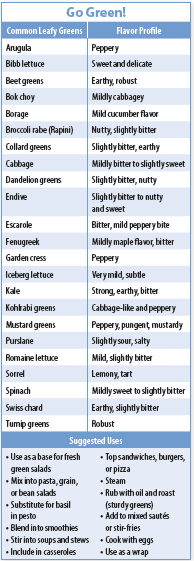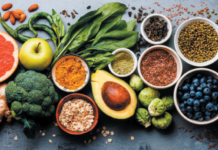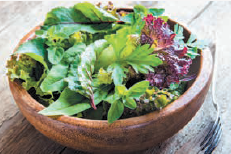What better way to welcome the season than to treat winter-weary palates to the splendor of leafy greens? Greens are packed with vitamins, minerals, phytonutrients, and fiber. From familiar favorites like spinach, romaine lettuce, collard greens, and kale to underutilized gems such as dandelion, purslane, and watercress, seize the season and explore the many ways of incorporating greens into your healthy dietary pattern.
The Goodness of Greens. Leafy greens are high in fiber and rich in vitamin K, vitamin A, vitamin C, vitamin E, and folate as well as minerals like iron, calcium, potassium, and magnesium. They also provide carotenoids and other phytonutrients linked to positive health effects.
Diets high in leafy greens have been associated with several health benefits, including lower risk of cardiovascular disease. A recent review of studies suggested leafy greens were associated with greater cardiovascular benefits than other vegetables when consumed as part of an overall healthy dietary pattern. Another recent trial found preliminary evidence that consumption of a cup of cooked leafy greens daily may reduce markers of colorectal cancer risk. Cruciferous leafy greens (such as cabbages, collard greens, kale, watercress, bok choy, and arugula) are among the best sources of glucosinolates, plant compounds which have been studied for their role in cancer prevention.
A randomized controlled trial found that adding two to three servings of vitamin K-rich leafy greens a day to habitual diets had a beneficial effect on markers of bone metabolism in middle aged and older individuals. Researchers are also exploring the link between leafy greens and brain health. An observational study found consumption of approximately one serving a day of leafy greens and other foods rich in vitamin K, lutein, folate, kaempferol, and alpha-tocopherol was associated with less cognitive decline in older adults.
Darker leaves generally contain more vitamins, minerals, and phytonutrients than lighter varieties. If you prefer the milder flavor of iceberg lettuce to the more intense bite of kale, for example, try mixing iceberg leaves with some romaine or baby spinach, gradually increasing the proportion of darker greens as your tastebuds adjust.
Plate Them. Leafy greens can be enjoyed raw or cooked, in an endless variety of dishes. See “Go Green!” for some ideas. If you choose fresh greens, avoid waste by purchasing the amount you plan to use in the next several days. Some varieties, especially spinach, kale, and collard greens, are available pre-washed, chopped, and then bagged or frozen for easy access any time. Refrigerate fresh raw greens, unwashed, to extend longevity. Unless you buy pre-washed raw greens, thoroughly rinse leaves before use. Limp leaves can be sauteed or added to smoothies, soups, sauces, stir-fries, or omelets. Thaw and drain frozen chopped spinach for a great addition to soups, quiches, lasagna, and smoothies.
Greens rich in iron, like kale and chard, are best enjoyed with citrus, strawberries, peppers, or other vitamin C-rich foods to enhance iron absorption. Pair greens with healthy fat sources, like soybean, olive, or other plant oils, to increase absorption of fat-soluble vitamins and phytonutrients.
When choosing fresh greens, look for bright green leaves, not yellowed or wilted. Smaller leaves are usually sweeter and are often better raw than larger leaves. Greens that tend to be bitter, like kale and collard greens, generally mellow when cooked. Young greens and small varieties (like arugula and watercress) have tender stems that can be eaten, but others, like kale and collards, may have thicker, fibrous stems that are best removed. Stems that are not quite so tough, like those of chard, are good when chopped small and added to the pan before the leaves to give them a bit of extra cooking time.
The Dietary Guidelines for Americans recommend eating two-and-a-half cup-equivalents of vegetables a day as part of a 2000 calorie diet. (One cup-equivalent equals one cup cooked greens or two cups raw.) It’s best to aim for a wide variety of colors, but make sure you are getting one-and-a-half to two cup-equivalents of dark green vegetables—including leafy greens—a week.
However you enjoy them—crisp and raw as a base for a salad, sautéed in oil and garlic, wilted into soups and mixed dishes, or whirled into smoothies—you can’t go wrong with versatile, nutritious leafy greens.
























